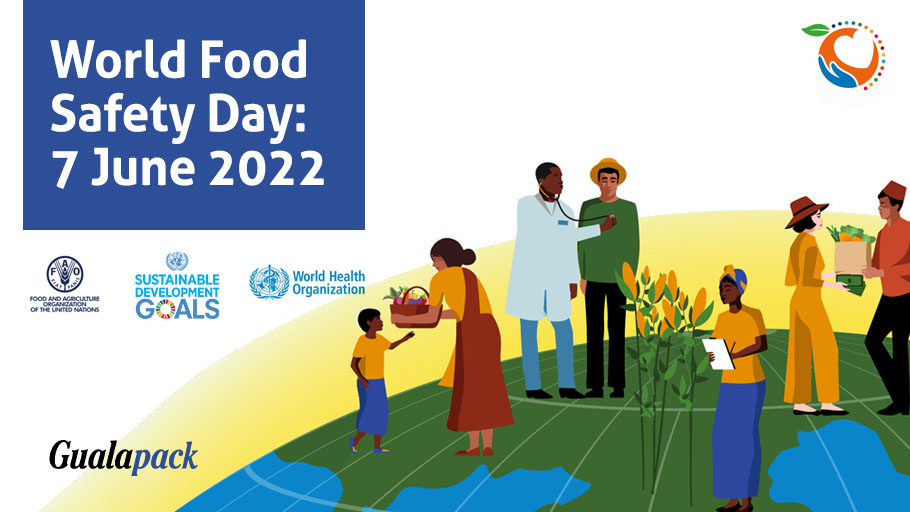Many activities must follow specific rules for food to stay safe all the way to the consumer’s table. As the final link, packaging protects the efforts made along the entire chain.
Food safety and food security are important interconnected challenges we must face to build a better future for the entire world.
Food safety deals with keeping food free of contamination and safe to eat, while food security regards people’s access to sufficient food on a regular basis. The latter is clearly highlighted in the UN’s 2030 Agenda under Sustainable Development Goal 2, “Zero hunger” – but the former may play a crucial role in achieving this goal as well. Because safer food means fewer resources wasted, extended shelf lives, the ability to transport products where they are needed, and an opportunity to balance availability in favour of those now lacking.
Food safety is a shared responsibility
Food producers and processors must comply with a variety of protocols and regulations, put in place specifically to minimise the risks for biological, chemical and physical hazards: from parasites to pesticides to small objects, every country and every industry has created systems and standards to protect consumers.
However, food safety is everyone’s responsibility: farmers and factory workers, packagers and warehouse managers, grocery stores, restaurants, cafeterias – down to each one of us, sitting at the table with a plate in front of us.
Why? Because the way we produce, store, handle and consume food can affect its safety. As the United Nations remind us, “Keeping food safe is a complex process that starts on the farm and ends with the consumer. All stages of the food chain, from harvest and production to distribution, storage and consumption, must be considered.”
The carbon footprint of food waste
According to studies conducted by the United Nation’s Food and Agriculture Organization (FAO), about one third of all food produced globally is wasted. This is true in both developing and developed economies, albeit for different reasons and in different parts of the food chain.
This huge and widespread misuse of resources is becoming a critical global issue, with the UN’s Sustainable Development Goals setting a target of halving food loss and waste by 2030.
Why such an ambitious target? The fact is food waste has far-reaching implications: according to FAO and the World Resources Institute, it accounts for 8% of global greenhouse gas emissions.
Again, every link in the chain has a responsibility to minimise waste: manufacturers can optimise their production and sales plans, intermediaries can find appropriate secondary markets or even donate overflow rather than letting food spoil, and consumers can shop more mindfully.
Single-portions are safer and less wasteful
Today’s advanced packaging systems help us do our part against waste. It may seem counter-intuitive, but single-portion packs can be the best environmental choice for any food that tends to quickly loose its qualities – think a family-sized bag of crisps that goes stale and ends up in the bin. Not to mention products such as yoghurt and liquid egg substitute, which once opened must be consumed within days to keep the food, and the family, safe.
Individual-serving packaging now comes in a variety of shapes and sizes – including options such as Gualapack’s easy-to-recycle Pouch5 and the innovative EasySnap sachet, which can be opened with just one hand to release only the perfect amount of dressing on your next salad.
Last, but definitely not least, special care must be put into guaranteeing the safety of children’s food. Gualapack offers a variety of pouches to keep baby food, fruit purées and other perishable snacks sealed safe and always convenient, even on the go, with the added value of spouts and caps specifically designed for the youngest consumers in mind. The company’s latest innovation is the tethered Babylink cap, which is both anti-choking and anti-litter, in line with the EU’s Single Use Plastics (SUP) Directive.
Flexible packaging seals the deal
Choosing flexible packaging is a great option to protect food because it is easy to customise according to specific protection criteria, always using the minimum amount of material. Some foods need high-temperature pasteurisation to extend their shelf life, while others must be sealed away from oxygen or humidity in the air: the right flexible packaging can do all of that, and more.
First of all, the most appropriate materials must be selected: often the combination of multi-layer films is the best option to benefit from different materials’ properties. On top of a variety of off-the-shelf packaging solutions, Gualapack offers a range of 2, 3 or 4-ply laminates for stand-up pouches, overwrapping, lids and more, including some monomaterial, polyolefin, bio-based and even compostable solutions.
By combining flexible packaging with the single-portion concept or a re-sealable solution, we can all keep food fresh and safe from contamination for longer. For our own health, to save resources and money, and to do our part to protect the environment.





